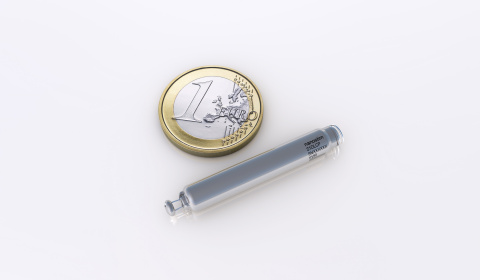ST. PAUL, Minn.--(BUSINESS WIRE)--St. Jude Medical, Inc. (NYSE:STJ), a global medical device company, today announced the first post-approval implant of the Nanostim™ leadless pacemaker in the U.K. The world’s first retrievable leadless pacemaker was implanted at St. Bartholomew’s Hospital in London by Professor Richard Schilling.
The Nanostim leadless pacemaker is designed to be placed directly in the heart without the visible surgical pocket, scar and insulated wires (called leads) required for conventional pacemakers. Implanted via the femoral vein with a steerable catheter, the device offers a less-invasive approach for physicians compared to traditional pacemaker procedures that require more invasive surgery. The device is designed to be fully retrievable so that it can be readily repositioned throughout the implant procedure and later retrieved if necessary.
Maureen McCleave, a 77-year-old from Chingford, became the first person in the U.K. to receive the Nanostim device. Having dealt with persistent atrial fibrillation for over a decade, Maureen often experienced periods of dizziness and fatigue that prevented her from participating in routine activities. In some extreme cases, her abnormal heart rhythm resulted in episodes where her heart would stop beating for up to five seconds at a time. Maureen’s procedure took just eight minutes to perform; she is already feeling more energetic and is looking forward to a full recovery.
"Nanostim is one of the most significant advancements in cardiology and pacemaker technology," said Professor Schilling, consultant at Barts Health NHS Trust. "This miniaturized, minimally-invasive cardiac pacemaker offers my patients the potential for reduced complications like infection and aesthetic benefits over conventional pacemakers, in addition to quicker recovery times. We are delighted to have conducted the first implants of this ground-breaking technology at St. Bartholomew’s Hospital in the U.K."
The Nanostim leadless pacemaker is less than 10 percent the size of a conventional pacemaker. The small size of the device and lack of a surgical pocket, coupled with the exclusion of a lead, improves patient comfort and can reduce complications, including device pocket-related infection and lead failure. The elimination of the visible lump and scar at a conventional pacemaker’s implant site, in addition to the removal of patient activity restrictions that may prevent the dislodgement or damage to a conventional lead, will potentially improve the quality of life for patients with this technology by allowing most to continue living active, uninhibited lifestyles. The device is supported by the St. Jude Medical Merlin™ Programmer, which is also used to interrogate and program the company’s other pacemakers and implantable cardioverter defibrillators (ICDs).
“The first post-approval implant in the U.K. is an important step for this revolutionary technology platform and a proud addition to St. Jude Medical’s strong history in pacing innovation,” said Paul Turner, vice president of St. Jude Medical U.K. “By providing a smaller, leadless pacing technology, physicians will now be able to offer patients a device that upholds the accuracy of conventional pacemaker technology via a minimally invasive procedure. We are pleased to offer this novel cardiac pacing technology to physicians and patients in the U.K.”
Initial results from the LEADLESS study, a prospective, single-arm, multicenter study evaluating patients with the Nanostim leadless pacemaker, were presented earlier this year and demonstrated overall device performance comparable to conventional pacemakers. Total implant procedure times averaged 28 minutes. Even with miniaturization, the device battery is expected to have an average lifespan of more than nine years at 100 percent pacing, or more than 13 years at 50 percent pacing.
Cardiac pacemakers are used to treat bradycardia, which is a heart rate that is too slow. These devices monitor the heart and provide electrical stimulation when the heart beats too slowly for each patient's specific physiological requirements. More than 4 million people worldwide have an implanted pacemaker or other cardiac rhythm management device, and an additional 700,000 patients receive the devices each year.
The Nanostim leadless pacemaker recently received CE Mark approval and is now available in select European markets. The Nanostim leadless pacemaker is not available for sale in the U.S.
About St. Jude Medical
St. Jude Medical is a global medical device manufacturer dedicated to transforming the treatment of some of the world’s most expensive, epidemic diseases. The company does this by developing cost-effective medical technologies that save and improve lives of patients around the world. Headquartered in St. Paul, Minn., St. Jude Medical has four major clinical focus areas that include cardiac rhythm management, atrial fibrillation, cardiovascular and neuromodulation. For more information, please visit sjm.com or follow us on Twitter @SJM_Media.
Forward-Looking Statements
This news release contains forward-looking statements within the meaning of the Private Securities Litigation Reform Act of 1995 that involve risks and uncertainties. Such forward-looking statements include the expectations, plans and prospects for the Company, including potential clinical successes, anticipated regulatory approvals and future product launches, and projected revenues, margins, earnings and market shares. The statements made by the Company are based upon management’s current expectations and are subject to certain risks and uncertainties that could cause actual results to differ materially from those described in the forward-looking statements. These risks and uncertainties include market conditions and other factors beyond the Company’s control and the risk factors and other cautionary statements described in the Company’s filings with the SEC, including those described in the Risk Factors and Cautionary Statements sections of the Company’s Annual Report on Form 10-K for the fiscal year ended December 29, 2012 and Quarterly Report on Form 10-Q for the fiscal quarter ended September 28, 2013. The Company does not intend to update these statements and undertakes no duty to any person to provide any such update under any circumstance.




